Discover and read the best of Twitter Threads about #IVUS
Most recents (12)
1/ For the fellows and #ACCEarlyCareer!
It’s a coronary thrombus! When to consider thrombectomy? What do you do? Let’s walk through this…#Tweetorial
#Cardiotwitter #Cardiology #STEMI
It’s a coronary thrombus! When to consider thrombectomy? What do you do? Let’s walk through this…#Tweetorial
#Cardiotwitter #Cardiology #STEMI

2/ Middle age patient with hx of CAD and PCI to LAD presents with significant SOB and elevated Hs-Trop. No chest pain. No ECG changes. Echo with inferior hypokinesis.
Here’s the diagnostic with a JR4.
Notice the filling defect in the RCA. This is thrombus. How do we know?
Here’s the diagnostic with a JR4.
Notice the filling defect in the RCA. This is thrombus. How do we know?
3/ Keys of #thrombus on angiogram
🔑 contrast staining
🔑 Lack of calcium on non con image
🔑 ovoid filling defect (complete lumen)
#Cardiotwitter #STEMI #TIMI
🔑 contrast staining
🔑 Lack of calcium on non con image
🔑 ovoid filling defect (complete lumen)
#Cardiotwitter #STEMI #TIMI

1/25
How would you tackle this heavily calcified LAD with calcified #nodule that was appropriately identified by intravascular imaging? #OCT
doi.org/10.1093/ehjcr/…
In this #EHJCaseReports #tweetorial we take a deep dive into the Rx of #calcified coronary lesions.
#Cardiotwitter
How would you tackle this heavily calcified LAD with calcified #nodule that was appropriately identified by intravascular imaging? #OCT
doi.org/10.1093/ehjcr/…
In this #EHJCaseReports #tweetorial we take a deep dive into the Rx of #calcified coronary lesions.
#Cardiotwitter

2/25
Calcified lesions are top of the totem pole of complex PCI
Main armamentaria are balloon-based #IVL & ablation-based (rotational/orbital) techniques, while ancillary tools eg guide extension catheters are useful too. eurointervention.pcronline.com/article/intrav…
#EHJCaseReports #tweetorial
Calcified lesions are top of the totem pole of complex PCI
Main armamentaria are balloon-based #IVL & ablation-based (rotational/orbital) techniques, while ancillary tools eg guide extension catheters are useful too. eurointervention.pcronline.com/article/intrav…
#EHJCaseReports #tweetorial

3/25
What do you see with this non-compliant balloon in this calcified RCA?
What would you do next? Poll in next tweet! doi.org/10.1093/ehjcr/…
What do you see with this non-compliant balloon in this calcified RCA?
What would you do next? Poll in next tweet! doi.org/10.1093/ehjcr/…

1/ Atypical CLOT- a tweetorial
I recently saw a controversial tweet arguing against tx of chronic clot and restricting tx SOLEY to the CFV/iliac. While I agree (for the most part)- data is limited. At the end of the day we care about the pt, and not every pt is the same! Case➡️
I recently saw a controversial tweet arguing against tx of chronic clot and restricting tx SOLEY to the CFV/iliac. While I agree (for the most part)- data is limited. At the end of the day we care about the pt, and not every pt is the same! Case➡️

#CathLabHack in @CCIJournal: #LiveIVUS technique in #UltraLowContrastPCI or #ZeroContrastPCI
onlinelibrary.wiley.com/doi/10.1002/cc…
@kerrigjl @agtruesdell @timir_paul @RajTayalMD @adityadoc1 @KardiologieHH @Michel_CorbanMD @aelsab @DrAmirKaki @mirvatalasnag @Pooh_Velagapudi @Umair2017


onlinelibrary.wiley.com/doi/10.1002/cc…
@kerrigjl @agtruesdell @timir_paul @RajTayalMD @adityadoc1 @KardiologieHH @Michel_CorbanMD @aelsab @DrAmirKaki @mirvatalasnag @Pooh_Velagapudi @Umair2017



2. Why is this needed?
Simple, fast, precise #UltraLowcontrast or #ZeroContrast #PCI
@AntoniousAttall @DrAFrangieh @rahilraf @nickaram @evhaddad @SarahFairley7 @mjlimmd @AnkurKalraMD @dimitri_zappi @gbiondizoccai @piccoloraf @ascenstthomas @crfheart #cardiotwitter #accic
Simple, fast, precise #UltraLowcontrast or #ZeroContrast #PCI
@AntoniousAttall @DrAFrangieh @rahilraf @nickaram @evhaddad @SarahFairley7 @mjlimmd @AnkurKalraMD @dimitri_zappi @gbiondizoccai @piccoloraf @ascenstthomas @crfheart #cardiotwitter #accic

3. #IVUS #DES Side by side - Combined entry profiles - 7F guide (6/7F #sheath) or 8F guide (#SheathlessRadial or #SafeFemoral) - Probably worth it to help avoid #CIN
@duanepinto @SukhNijjer @drandrewsharp @Allison_Dupont @esbrilakis @DLBHATTMD @Drroxmehran @twj1974 @ekgpdx
@duanepinto @SukhNijjer @drandrewsharp @Allison_Dupont @esbrilakis @DLBHATTMD @Drroxmehran @twj1974 @ekgpdx

1/ #Tweetorial Part 2- Now its time to talk about….
CHRONIC
C-L-O-T
#VTE #DVT #Thrombectomy #Lytics #Cardiotwitter #IRAD #Medthread #Clot @CardioBot @RadialFirstBot @BotPci @EPeeps_Bot @TAVRBot @MedTweetorials @UjjwalRastogiMD @Umair2017 @Umair2017 @VenuVadlamudiMD
CHRONIC
C-L-O-T
#VTE #DVT #Thrombectomy #Lytics #Cardiotwitter #IRAD #Medthread #Clot @CardioBot @RadialFirstBot @BotPci @EPeeps_Bot @TAVRBot @MedTweetorials @UjjwalRastogiMD @Umair2017 @Umair2017 @VenuVadlamudiMD

2/ How much time does it take for #ChronicClot to START to form?
#Fellowstwitter #fellows #fellowtwitter #medtwitter #Clottwitter #VTE @MedTweetorials @CardioBot #Tweetorial #Meded @GAEscobarMD @ekgpdx @HeartOTXHeartMD @EM_RESUS @Pooh_Velagapudi @Vascupedia_com @Dr_Bowser
#Fellowstwitter #fellows #fellowtwitter #medtwitter #Clottwitter #VTE @MedTweetorials @CardioBot #Tweetorial #Meded @GAEscobarMD @ekgpdx @HeartOTXHeartMD @EM_RESUS @Pooh_Velagapudi @Vascupedia_com @Dr_Bowser
1/ Welcome to the first part of a #Tweetorial series on #VenousDisease.
🩸To begin how about we talk about the main player in the game- C.L.O.T. (and why you should care about it)
#Cardiotwitter #Irad #fellows #fellowtwitter #medthread #clot #medtwitter #clottwitter
🩸To begin how about we talk about the main player in the game- C.L.O.T. (and why you should care about it)
#Cardiotwitter #Irad #fellows #fellowtwitter #medthread #clot #medtwitter #clottwitter
2/ But first a question- Is there a difference between arterial and venous clot??
#Clot #cardiology #DVT #irad #VenousDisease #medthread #tweetorial #fellows @HadyLichaaMD @VladLakhter @agtruesdell @AntoniousAttall @TheNarulaSeries @t_intheleadcoat @ShariqShamimMD
#Clot #cardiology #DVT #irad #VenousDisease #medthread #tweetorial #fellows @HadyLichaaMD @VladLakhter @agtruesdell @AntoniousAttall @TheNarulaSeries @t_intheleadcoat @ShariqShamimMD
AGIKplenum: Unverzichtbar im Katheterlabor!?
(Raum 12 @kardiologie_org)
❤️Erster Vortrag:
Intravaskuläre Bildgebung📸 (David Leistner | @m_leistner | Berlin)
#DGKJahrestagung @HolgerNef @kaschenke @MarcVorpahl @thiele_holger
(Raum 12 @kardiologie_org)
❤️Erster Vortrag:
Intravaskuläre Bildgebung📸 (David Leistner | @m_leistner | Berlin)
#DGKJahrestagung @HolgerNef @kaschenke @MarcVorpahl @thiele_holger

1/24
A picture is worth a thousand words. This month's #EHJCaseReports tweetorial focuses on intravascular imaging in coronary intervention.
For starters, what do you see on this #OCT image of an intracoronary honeycomb🐝?
academic.oup.com/ehjcr/article/…
Poll 👇
#cardiotwitter
A picture is worth a thousand words. This month's #EHJCaseReports tweetorial focuses on intravascular imaging in coronary intervention.
For starters, what do you see on this #OCT image of an intracoronary honeycomb🐝?
academic.oup.com/ehjcr/article/…
Poll 👇
#cardiotwitter
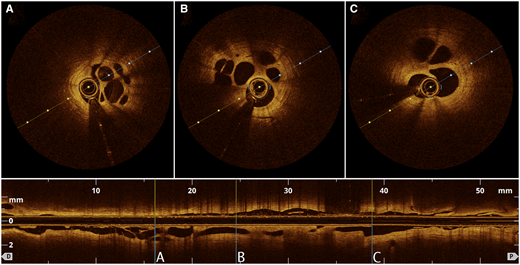
2/24
The intracoronary honeycomb on the image above is ⬇️
Find out the answer in #EHJCaseReports:
academic.oup.com/ehjcr/article/…
The intracoronary honeycomb on the image above is ⬇️
Find out the answer in #EHJCaseReports:
academic.oup.com/ehjcr/article/…
3/24
Honeycomb-like structure, a rare cause of myocardial ischaemia has multiple communicating channels divided by thin septa. Angiographically fuzzy & hazy appearance often without significant stenosis, they're best detected on high-resolution IVUS/OCT
academic.oup.com/ehjcr/article/…
Honeycomb-like structure, a rare cause of myocardial ischaemia has multiple communicating channels divided by thin septa. Angiographically fuzzy & hazy appearance often without significant stenosis, they're best detected on high-resolution IVUS/OCT
academic.oup.com/ehjcr/article/…

Check out the #MINOCA section in updated NSTE-ACS guidelines at #ESCcongress
bit.ly/3bcrixp
Here is a tweetorial on #MINOCA
🧲Class I Recommendations🧲
-> Use of Diagnostic algorithm
-> Use of #whyCMR
-> Use of working dx & Rx according to the underlying Dx
bit.ly/3bcrixp
Here is a tweetorial on #MINOCA
🧲Class I Recommendations🧲
-> Use of Diagnostic algorithm
-> Use of #whyCMR
-> Use of working dx & Rx according to the underlying Dx
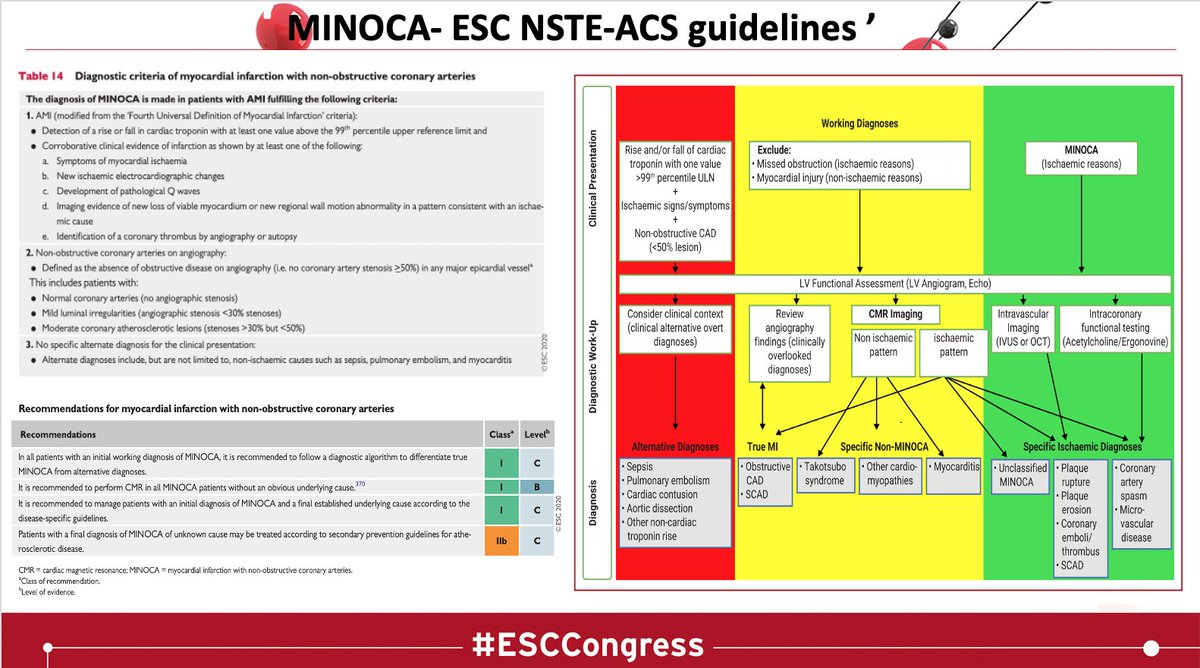
MINOCA has MI in it-> DOES the definition allows for the inclusion of non-ischemic causes of troponin elevation?
Given this limitation of the troponin bioassay, the “Fourth 4th Universal of MI" defined Injury from infarction
INJURY IS NECROSIS WITHOUT ISCHEMIA!
#ESCCongress

Given this limitation of the troponin bioassay, the “Fourth 4th Universal of MI" defined Injury from infarction
INJURY IS NECROSIS WITHOUT ISCHEMIA!
#ESCCongress
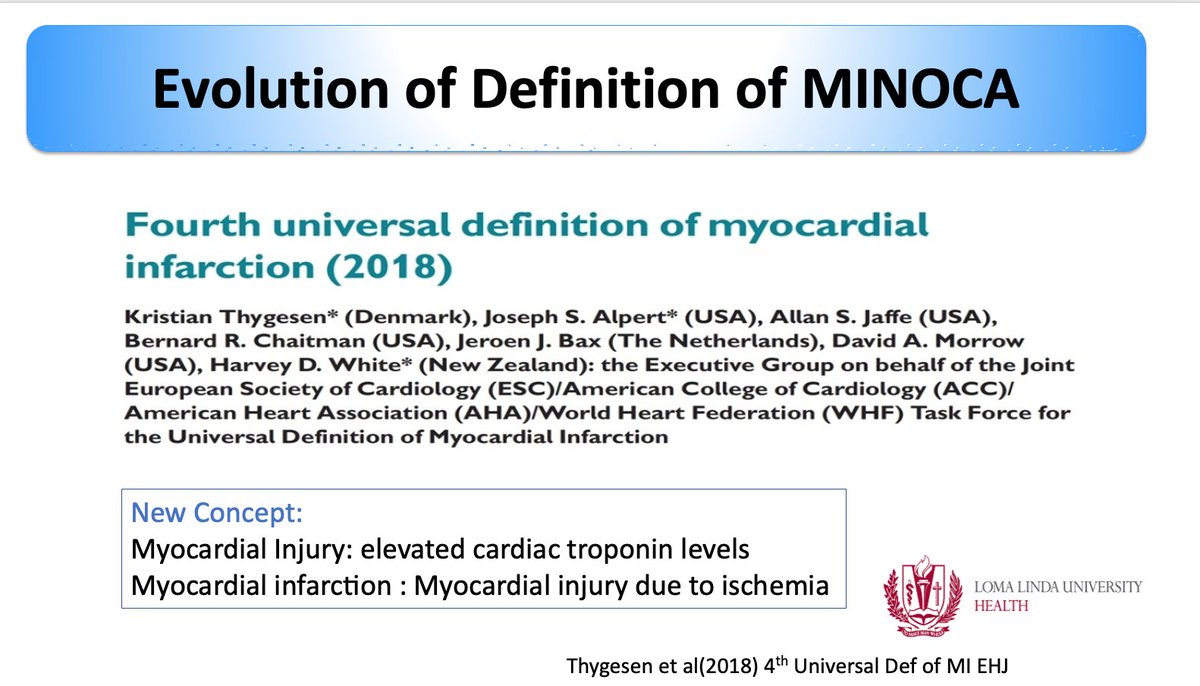
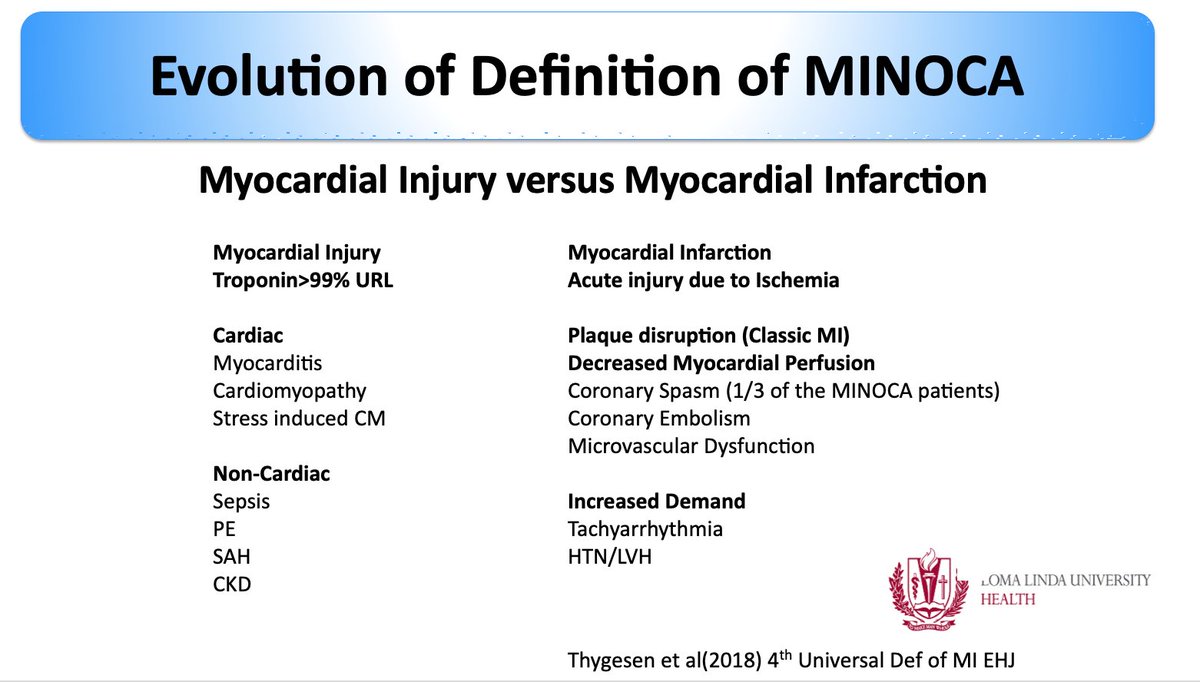
The hallmark of myocardial injury ⬆️ troponin, However, these entities differ conceptually
▶️ myocardial injury = nonischemic mechanisms of myocyte injury (eg, myocarditis),
▶️MI = ischemic mechanisms (eg,
plaque disruption or supply-demand mismatch).
#ESCCongress

▶️ myocardial injury = nonischemic mechanisms of myocyte injury (eg, myocarditis),
▶️MI = ischemic mechanisms (eg,
plaque disruption or supply-demand mismatch).
#ESCCongress
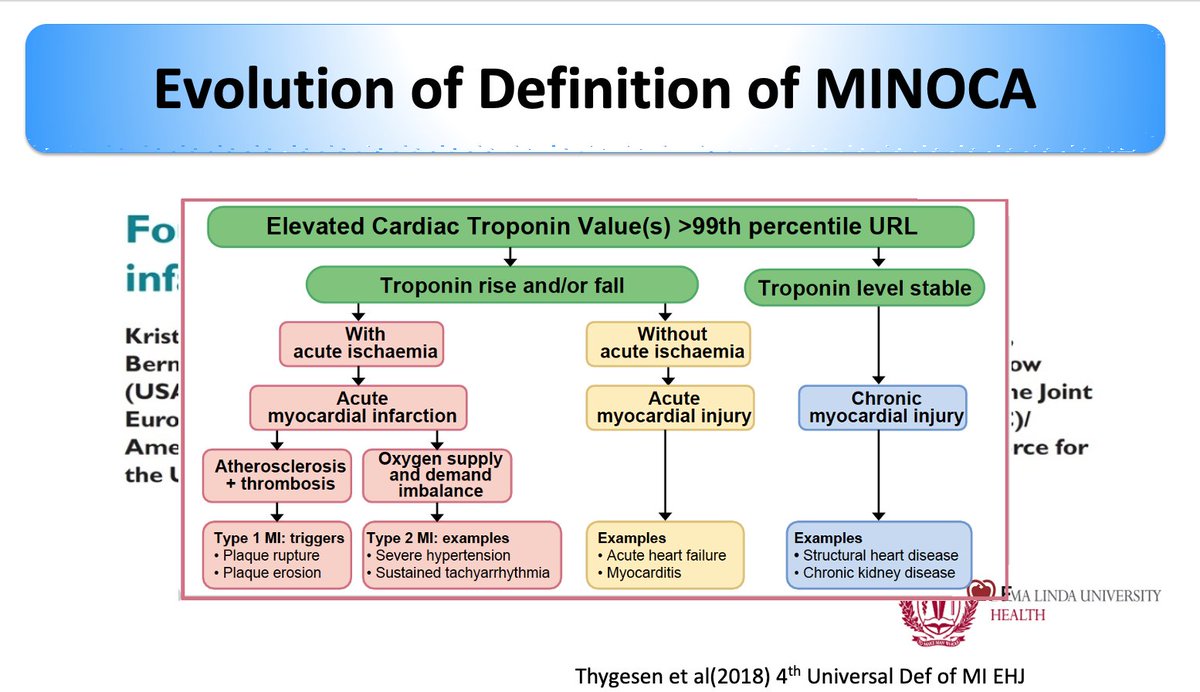
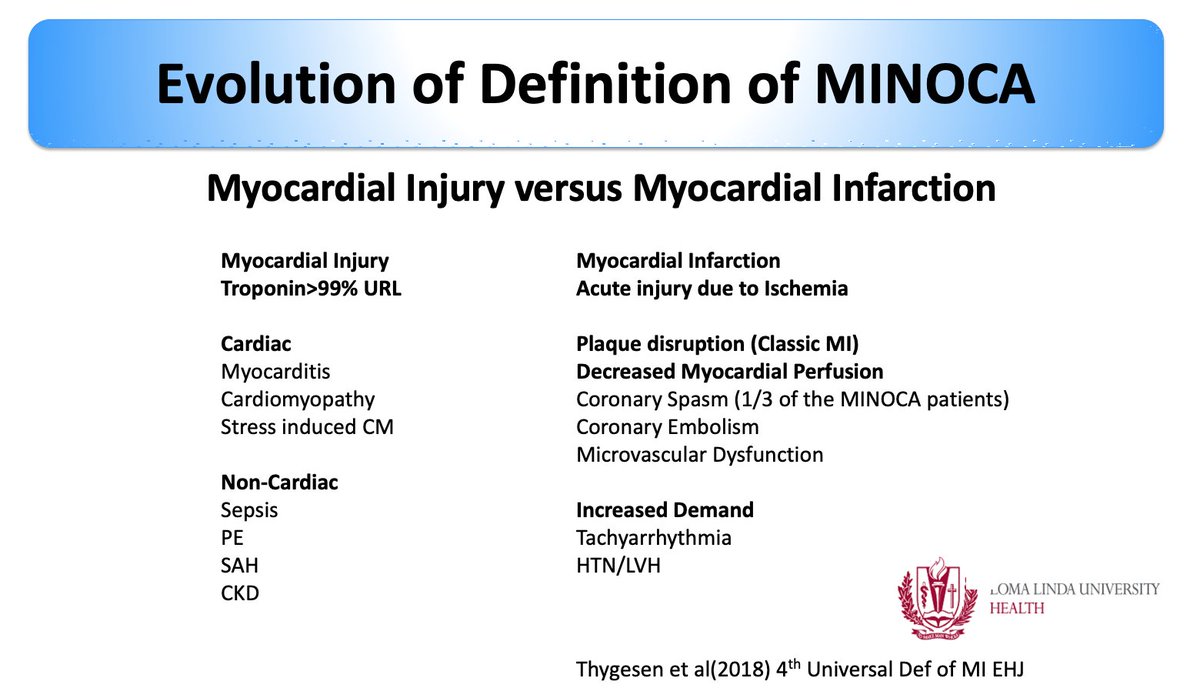
Role of imaging #OCT #IVUS #WhyCMR in #MINOCA
I want to thank my co-authors
@JelaniAini @twj1974 @biljana_parapid @MBalghith @drptca ⤵️⤵️
I want to thank my co-authors
@JelaniAini @twj1974 @biljana_parapid @MBalghith @drptca ⤵️⤵️
⚡️ Coronary Microvascular Dysfunction is Associated with Significant Plaque Burden & Diffuse Epicardial Atherosclerotic Disease
@JACCJournals
interventions.onlinejacc.org/content/12/15/…
#JACCINT #CMD #CardioTwitter
Let's discuss this paper in 2 Tweets 👇
@JACCJournals
interventions.onlinejacc.org/content/12/15/…
#JACCINT #CMD #CardioTwitter
Let's discuss this paper in 2 Tweets 👇

What’s Your “Shear Stress”?
Want to Know More?
Relax & Read ⤵️ #Tweetorial by @CoronaryDoc + @arnavkumar
⚡️Coronary Wall Shear Stress in 12 Tweets ⚡️
1/12
Main Readings:
1) interventions.onlinejacc.org/content/early/…
2) ow.ly/XmD130mc9X8
3) link.springer.com/article/10.100…
#ACCImaging @ACCCardioEd
Want to Know More?
Relax & Read ⤵️ #Tweetorial by @CoronaryDoc + @arnavkumar
⚡️Coronary Wall Shear Stress in 12 Tweets ⚡️
1/12
Main Readings:
1) interventions.onlinejacc.org/content/early/…
2) ow.ly/XmD130mc9X8
3) link.springer.com/article/10.100…
#ACCImaging @ACCCardioEd
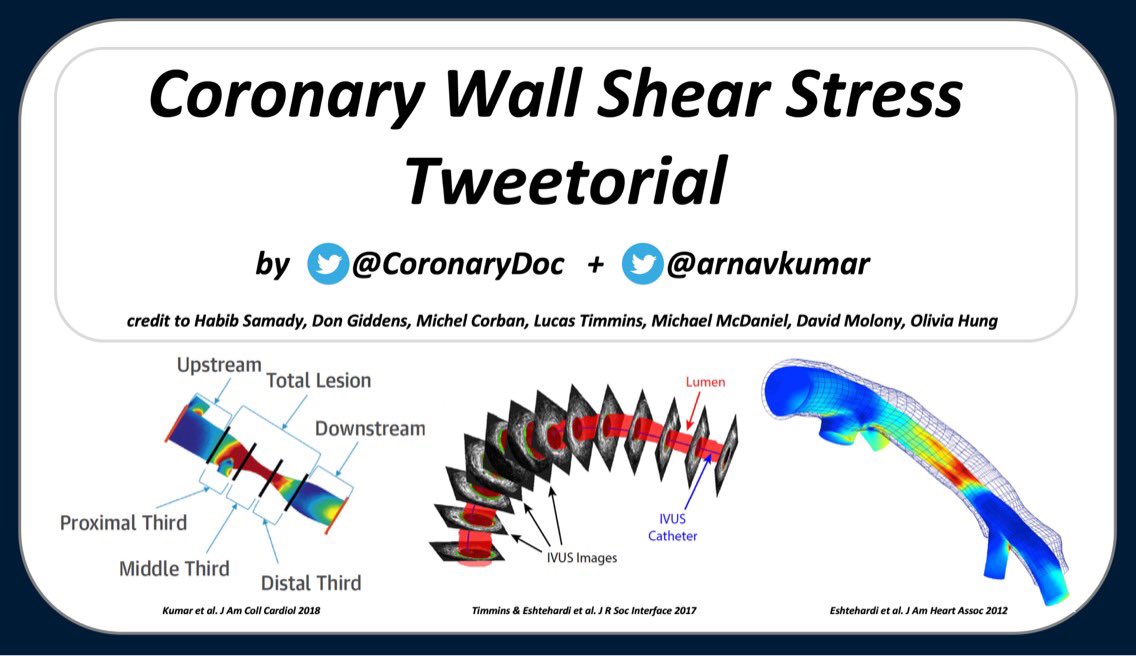
2/12
Wall shear stress (#WSS) is the frictional force of blood exerted tangential to endothelial surface of vessel wall & expressed in variety of units (1Pa=1N/m2=10 dynes/cm2)
It is derived from
• luminal geometry
• flow rate
• blood viscosity
• near wall velocity values
Wall shear stress (#WSS) is the frictional force of blood exerted tangential to endothelial surface of vessel wall & expressed in variety of units (1Pa=1N/m2=10 dynes/cm2)
It is derived from
• luminal geometry
• flow rate
• blood viscosity
• near wall velocity values

3/12
In vivo WSS calculations are derived from computational fluid dynamic (#CFD) simulations created from reconstructed 3D vessel geometries (from biplane angio/IVUS/OCT/CT/MR) combined with patient-specific pulsatile inlet/outlet velocity values (Doppler wire or other methods)
In vivo WSS calculations are derived from computational fluid dynamic (#CFD) simulations created from reconstructed 3D vessel geometries (from biplane angio/IVUS/OCT/CT/MR) combined with patient-specific pulsatile inlet/outlet velocity values (Doppler wire or other methods)






















